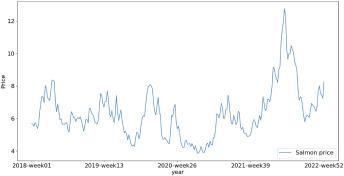After a period of gains, Norway’s salmon spot prices have hit a pause, signaling a potential shift in market dynamics. Meanwhile, Scottish salmon prices continue their upward trajectory, reflecting sustained demand and supply factors. In contrast, Chilean salmon spot prices remain largely steady, indicating stable market conditions amid varied regional influences. This latest development underscores the evolving landscape of the global salmon market, with implications for producers and buyers alike.
Norway Salmon Spot Price Plateau Signals Market Uncertainty
After weeks of upward momentum, the spot price for Norwegian salmon has reached a noticeable plateau, reflecting a moment of hesitation among buyers and sellers alike. Market participants are watching closely as supply levels stabilize while demand shows signs of cautious retrenchment amid ongoing geopolitical and environmental uncertainties. This price stabilization contrasts sharply with the continued ascent in Scottish salmon prices, driven by tighter availability and robust demand, and the steadiness observed in the Chilean market, where supply chains maintain equilibrium despite variable export conditions.
Key factors influencing current market dynamics include:
- Heightened concerns over feed cost inflation impacting Norwegian harvest valuations.
- Shifts in European consumer demand patterns, affecting order volumes.
- Logistical bottlenecks and export restrictions shaping regional price behavior.
- Seasonal harvesting schedules influencing supply balance across producing nations.
| Region | Price Trend | Market Outlook |
|---|---|---|
| Norway | Plateaued | Uncertain, watchful |
| Scotland | Climbing | Strong demand, constrained supply |
| Chile | Stable | Balanced supply and demand |
Scottish Salmon Prices Continue Upward Trend Amid Strong Demand
Scottish salmon continues to attract strong interest from buyers, pushing prices higher despite fluctuations in other key markets. While Norway saw its spot price stabilize after a recent lift, Scotland’s salmon prices maintained an upward trajectory, driven by robust demand across European and North American markets. Suppliers report constrained harvest volumes due to lingering impacts from environmental challenges, which only intensify competition for available stocks.
Market analysts highlight several factors supporting this price momentum:
- Export demand outpaces supply as consumer appetite for premium seafood remains resilient.
- Improved quality standards from Scottish farms bolster product appeal and command premium pricing.
- Seasonal limitations reduce fish availability, reinforcing upward price pressure.
| Origin | Spot Price (USD/kg) | Price Trend |
|---|---|---|
| Scottish Salmon | 8.75 | Rising |
| Norway Salmon | 8.40 | Stable |
| Chilean Salmon | 7.90 | Steady |
Chilean Salmon Market Holds Steady Despite Global Supply Fluctuations
Despite ongoing global disruptions affecting seafood supply chains, the Chilean salmon market has showcased remarkable resilience this quarter. While Norway experienced a temporary lift in spot prices that has now plateaued, and Scotland reports a steady upward trajectory, Chile remains firmly anchored with stable prices. Industry insiders attribute this steadiness to Chile’s robust production cycles and improved biosecurity measures that have mitigated past disease challenges, allowing consistent year-round supply to both domestic and export markets.
Key factors contributing to Chile’s salmon stability include:
- Enhanced hatchery technology ensuring reliable fingerling outputs
- Strategic exports focused on high-demand Asian markets
- Effective containment of algal bloom impacts
- Streamlined logistics reducing time-to-market delays
| Country | Salmon Price Trend | Average Spot Price (USD/kg) | Production Status |
|---|---|---|---|
| Chile | Steady | 7.25 | Normal |
| Norway | Plateau | 8.10 | Seasonal Fluctuations |
| Scotland | Rising | 7.85 | Good |
Closing Remarks
As the salmon market continues to navigate shifting dynamics, Norway’s spot price increase has paused, reflecting a cautious stance among traders. Meanwhile, Scottish prices maintain their upward momentum, signaling sustained demand and regional supply factors. Chilean prices remain steady, underscoring stable market conditions in the Southern Hemisphere. Industry stakeholders will be watching closely in the coming weeks to see how these regional trends evolve and influence global salmon trade.
















